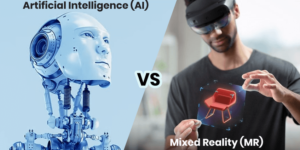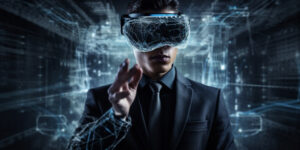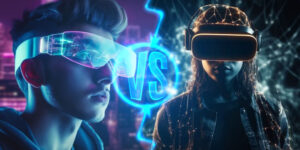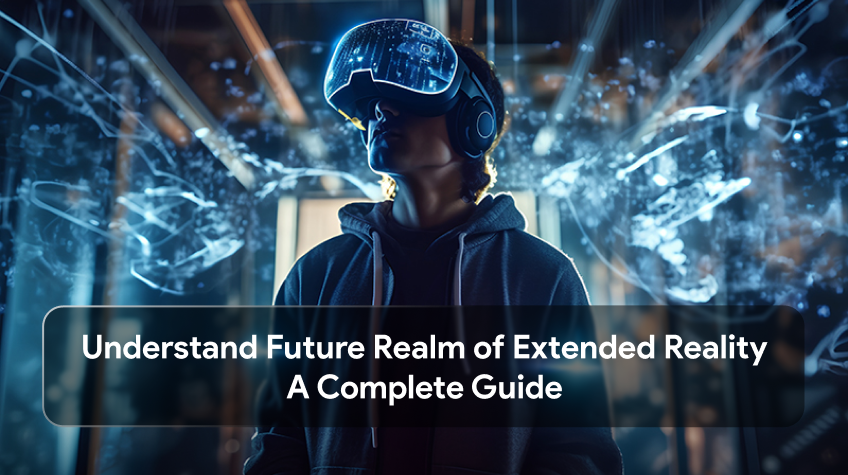
Introduction
Embarking on a journey through the digital frontier, Extended Reality (XR) emerges as a transformative force, seamlessly blending the realms of Virtual Reality (VR), Augmented Reality (AR), and Mixed Reality (MR). XR is not merely a technological convergence; it represents a paradigm shift, redefining how we interact with our surroundings.
The evolutionary timeline of XR technology unfolds with each innovation, propelling us into immersive and interactive experiences. Its significance reverberates across diverse industries, from revolutionizing gaming landscapes to enhancing healthcare practices. Join us as we delve into the dynamic landscape of XR, unlocking its potential to reshape our reality.
Understanding Extended Reality (XR)
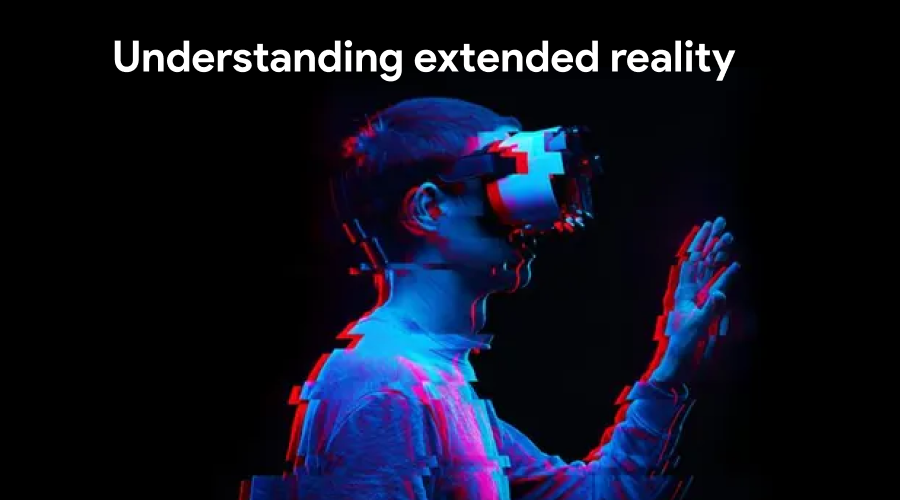
Embarking on the digital frontier, Extended Reality (XR) introduces a spectrum of immersive experiences that seamlessly blend the virtual and the real. Let’s unravel the core elements of XR and explore its diverse technologies.
i. Overview of Extended Reality (XR) Technology
- Virtual Reality (VR): Plunging users into entirely simulated environments, VR engulfs them in a fabricated reality, often with headsets and controllers.
- Augmented Reality (AR): Enhancing the real-world environment by overlaying digital elements, AR supplements our perception through devices like smartphones or AR glasses.
- Mixed Reality (MR): By bridging the gap between VR and AR, MR intertwines virtual and real elements, allowing users to interact seamlessly.
ii. Core Features of Extended Reality (XR)
- Immersion: XR captivates users by creating a sense of presence within virtual environments, blurring the lines between reality and simulation.
- Interaction: Enabling users to engage with digital elements, XR leverages gestures, voice commands, and tactile feedback for a more dynamic experience.
- Integration: XR seamlessly incorporates digital content into the real world, fostering a cohesive blend of virtual and physical elements.
XR technology redefines our perceptions—immersing us in virtual realms, augmenting our reality, and seamlessly integrating digital and physical worlds.
Applications of Extended Reality (XR)
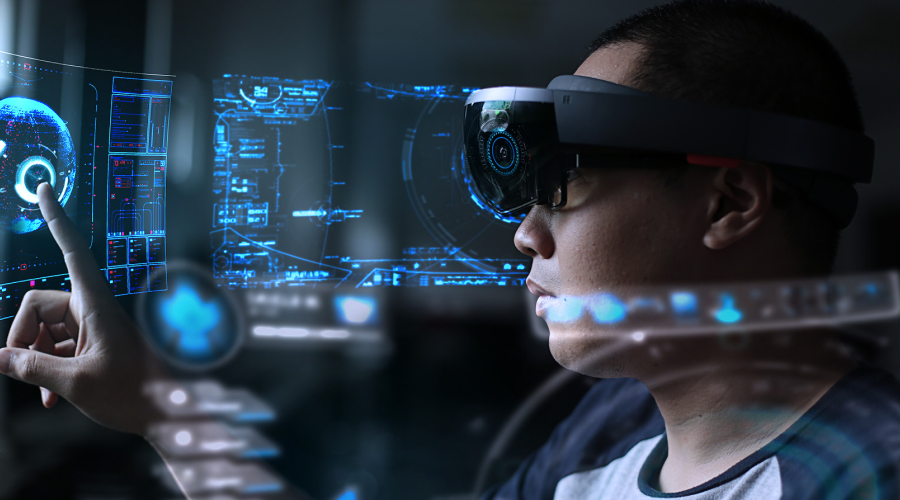
Embarking on the digital frontier, xr reality transcends the boundaries of imagination, impacting diverse sectors with its revolutionary applications.
i. Gaming and Entertainment
- VR Gaming: Immerse yourself in alternate realities, elevating gaming experiences to unprecedented heights.
- AR in Gaming: Blend fantasy with reality as augmented elements enrich the gaming landscape, creating a dynamic and interactive environment.
ii. Healthcare
- Surgical Training through VR: Propel medical education into the future, allowing surgeons to practice and refine their skills in realistic virtual environments.
- AR for Medical Imaging: Enhance diagnostic precision by overlaying critical information onto real-world medical images, aiding healthcare professionals in decision-making.
iii. Education
- Virtual Classrooms: Break down geographical barriers, providing students with immersive learning experiences in virtual spaces.
- Interactive Learning with AR: Augment traditional teaching methods with interactive elements, fostering engagement and comprehension.
iv. Manufacturing and Design
- Prototyping in VR: Revolutionize product development by creating and refining prototypes in virtual spaces, expediting the design process.
- AR for Assembly Line Assistance: Improve efficiency in manufacturing, guiding workers through complex assembly processes with augmented visual instructions.
v. Retail
- Virtual Try-Ons: Redefine the shopping experience by allowing customers to try on products virtually, enhancing their decision-making process.
- AR Shopping Experiences: Transform brick-and-mortar and online retail spaces with augmented elements, providing personalized and interactive shopping journeys.
XR reality applications transcend industries, offering a spectrum of experiences from immersive gaming to revolutionizing education, healthcare, manufacturing, and retail.
Features of Extended Reality (XR) Technologies
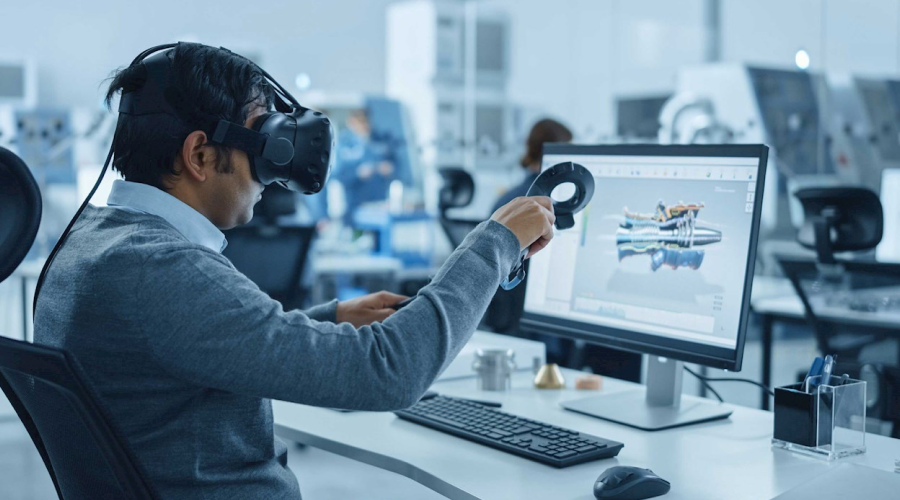
Embarking on the digital frontier, xr reality is not just a technological convergence but a gateway to immersive experiences. Let’s explore the key features that make XR technologies a paradigm shift in how we interact with the digital realm.
i. Immersive Environments
- Realistic Graphics and Sound: Dive into lifelike simulations with cutting-edge graphics and spatial audio, intensifying the sense of presence in virtual worlds.
- Haptic Feedback: Enhance immersion with tactile sensations, allowing users to feel and interact with the virtual environment through haptic feedback.
ii. Interaction and Engagement
- Gesture Recognition: Break free from traditional interfaces as XR systems interpret and respond to natural hand movements, fostering intuitive and engaging interactions.
- Voice Commands: Seamlessly control and navigate XR experiences through voice commands, offering a hands-free and efficient mode of interaction.
iii. Cross-Platform Integration
- Compatibility with Various Devices: Enjoy flexibility as XR technologies adapt to various devices, from VR headsets to AR glasses, ensuring platform accessibility.
- Seamless Connectivity: Experience a cohesive digital landscape as XR systems seamlessly connect with other devices, enabling smooth transitions between virtual and physical spaces.
Extended reality technology redefines the user experience with lifelike immersion, intuitive interactions, and seamless integration across various platforms and devices.
Benefits of Implementing Extended Reality (XR)
Venturing into Extended Reality technology, the benefits it bestows upon industries and individuals are nothing short of transformative. Let’s explore the manifold advantages that come with the implementation of XR technologies.
i. Enhanced Learning and Training
- Immersive Education: XR creates lifelike learning environments, offering hands-on experiences in medicine, engineering, and more.
- Skill Refinement: In professions ranging from surgery to manufacturing, XR facilitates realistic simulations for continuous skill enhancement.
ii. Improved Decision-Making
- Data Visualization: XR aids professionals by visualizing complex data sets comprehensibly, enhancing their ability to make informed decisions.
- Interactive Simulations: Simulate various scenarios, enabling decision-makers to anticipate outcomes and devise effective strategies.
iii. Increased Productivity
- Virtual Collaboration: XR transcends geographical constraints, fostering collaborative work environments where teams can interact seamlessly in virtual spaces.
- Efficient Training Programs: XR reduces training time by providing hands-on experiences, accelerating the learning curve for new skills.
iv. Cost Savings
- Remote Operations: XR allows for remote maintenance and operation, reducing the need for physical presence and associated travel costs.
- Virtual Prototyping: Industries can save costs by creating and testing prototypes in virtual spaces before committing to physical production.
v. Enhanced Customer Experiences
- Personalized Interactions: Retailers leverage XR for personalized shopping experiences, offering virtual try-ons and immersive product demonstrations.
- Interactive Marketing: XR transforms advertising and marketing strategies, captivating customers with engaging and interactive campaigns.
Implementing XR translates into a future where learning becomes immersive, decisions are well-informed, productivity soars, costs are curtailed, and customer experiences are elevated to new heights.
Challenges and Considerations
Embarking on the transformative journey of Extended Reality technology, it is crucial to recognize the challenges and considerations associated with this cutting-edge technology. As we navigate the potential of XR, let’s explore the hurdles that demand careful attention.
i. Technical Limitations
- Hardware Requirements: High-performance hardware is expensive, making it difficult to adopt widely.
- Resolution and Latency: Achieving realistic experiences hinges on overcoming challenges related to resolution and latency, ensuring a seamless user experience.
ii. Privacy and Security Concerns
- Data Protection: XR applications often collect sensitive data, necessitating robust measures to safeguard user privacy.
- Cybersecurity Risks: As XR systems become more interconnected, the risk of cyber threats increases, requiring stringent security protocols.
iii. Adoption and Integration Challenges
- Lack of Standardization: The lack of standardized protocols can impede interoperability and hinder the seamless integration of XR across industries.
- User Acceptance: Overcoming skepticism and fostering user acceptance is crucial, as unfamiliarity with XR may lead to resistance to adopting new technologies.
The journey into the realm of XR has challenges, ranging from technical limitations and privacy concerns to the complexities of adoption and integration. Taking these hurdles into account is crucial to maximizing the potential of Extended Reality.
Real-world Examples of Extended Reality (XR)
Embarking on a voyage through the tangible impacts of Extended Reality (XR), real-world examples illustrate how this transformative technology transcends conceptual realms. Let’s delve into instances where XR is not just a visionary concept but a tangible force reshaping industries.
i. Oculus Rift in Gaming
- Immersive Gameplay: Oculus Rift has revolutionized gaming, offering users an unparalleled immersive experience in virtual worlds.
- Motion Tracking: Precise motion tracking technology enables users to interact with virtual environments through natural movements.
ii. Microsoft HoloLens in Healthcare
- Surgical Assistance: HoloLens aids surgeons with holographic visualizations during complex surgeries, enhancing precision and decision-making.
- Medical Training: Healthcare professionals use HoloLens for realistic medical training, creating scenarios for hands-on learning.
iii. Google Glass in Enterprise
- Hands-Free Assistance: Google Glass provides workers with access to information, instructions, and communication in various industries.
- Logistics and Maintenance: In enterprise settings, Google Glass aids logistics and maintenance tasks by providing real-time data and guidance.
iv. Magic Leap in Education
- Immersive Learning: Magic Leap transforms classrooms by bringing educational content to life with holographic experiences.
- Interactive Simulations: Students engage in interactive simulations, enhancing their understanding of complex subjects in a virtual environment.
These real-world examples showcase the tangible impact of XR, from revolutionizing gaming experiences with Oculus Rift to empowering healthcare professionals through Microsoft HoloLens and fostering hands-free productivity in enterprise settings with Google Glass.
Future Trends in Extended Reality (XR)
Embarking on the future of Extended Reality (XR), the trajectory unfolds with dynamic trends that promise to reshape our digital landscape. As we peer into the horizon, three significant trends appear, offering insight into future developments in the evolution of XR.
i. Advancements in Hardware
- Slimmer and Lighter Devices: Future XR hardware is poised to be more ergonomic, focusing on reducing weight and enhancing user comfort.
- Improved Display Technologies: Advanced display technologies, including higher resolutions and broader fields of view, will contribute to more immersive XR experiences.
- Biometric Integration: Anticipate the incorporation of biometric sensors into XR devices for enhanced user interaction and personalized experiences.
ii. Integration with Artificial Intelligence
- Smart XR Environments: AI integration will enable XR environments to adapt and respond intelligently to user behavior and preferences.
- Real-time Personalization: AI algorithms will be crucial in tailoring XR experiences in real time, making them more intuitive and personalized.
- Cognitive Enhancements: To enrich XR interactions, expect AI-driven cognitive enhancements, such as improved natural language processing and context awareness.
iii. Expansion of Extended Reality (XR) in Business Processes
- Enterprise-wide XR Integration: XR technologies will become integral to various business processes, from training and collaboration to customer interactions.
- Data Visualization for Decision-Making: XR will be increasingly employed for visualizing complex data sets, aiding decision-makers in comprehending intricate information.
- Remote Work Revolution: XR will play a pivotal role in fostering remote collaboration, creating virtual workspaces that transcend physical boundaries.
Advancements in hardware mark the future of XR, deeper integration with artificial intelligence, and an expansive role in transforming diverse business processes. These trends herald an era where XR becomes not just a tool but a vital part of our everyday digital experiences.
In closing, the odyssey through Extended Reality (XR) reveals a transformative force poised to redefine how we perceive and interact with the digital world. From immersive gaming realms to revolutionary applications in healthcare, education, and beyond, XR’s impact is dynamic and far-reaching.
As we navigate challenges like technical limitations and privacy concerns, the promising trajectory of extended reality unfolds with advancements in hardware, seamless integration with artificial intelligence, and its pervasive role in shaping business processes. The future promises innovation and a seamless fusion of the virtual and real, where XR becomes an indispensable part of our daily lives. Embrace the evolution, for in xr reality, we discover not just a technology but a gateway to boundless opportunities.


